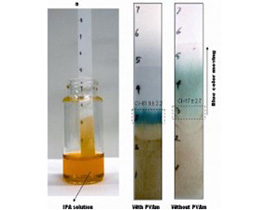5 minutes to detect pesticides in food
Canadian scientists have created a device that can quickly detect pesticide residues in food for a maximum of 5 minutes.

Insecticide test strip "Dipstick".(Photo: www.chemie.de)
Researcher John Brennan of McMaster University and colleagues created a 10cm-long paper stick, called "Dipstick," that can detect pesticides found in food or drinks, even if only strong very small.
This test tool can be used to test imported food samples from countries that normally use banned pesticides in Canada.
When detecting pesticide residues in excess of permitted levels, this test strip will change color, which can be easily seen with the naked eye. The "Dipstick" can also be used in the military to detect chemical warfare types.
This type of test strip is suitable for developing countries where modern and expensive food safety inspection equipment cannot be equipped to remote areas.
In addition, this test device is also very simple, does not need experts to analyze samples. This type of rod can also equip food processing plants to prevent the risk of disease outbreaks.
Currently, "Dipstick" can detect 5 or 6 types of toxic chemicals in food. In the future, this device can be used to detect potentially deadly bacteria such as E.coli, Listeria or Salmonella.
- How to 'reduce' pesticides in vegetables
- Detecting toxins in food after 10 minutes thanks to nano silver
- 'Vaccinate' plants to fight pests and diseases
- Detection: Good pesticides for mulberry trees but for silkworms
- Advanced technologies help detect dirty food
- Video: History of invention and use of pesticides
- Tell you 4 best ways to remove pesticides, toxic chemicals on vegetables
- The risk of children with autism is caused by their mother's exposure to pesticides during pregnancy
- The US government is sued for bees
- Turn cigarettes into pesticides
- Pesticides from plants
- Mobile devices can detect viruses in minutes
 Green tea cleans teeth better than mouthwash?
Green tea cleans teeth better than mouthwash? Death kiss: This is why you should not let anyone kiss your baby's lips
Death kiss: This is why you should not let anyone kiss your baby's lips What is salmonellosis?
What is salmonellosis? Caution should be exercised when using aloe vera through eating and drinking
Caution should be exercised when using aloe vera through eating and drinking